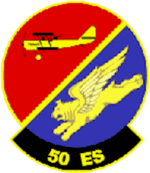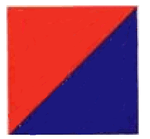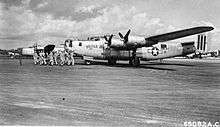50th Attack Squadron
| 50th Attack Squadron | |
|---|---|
 Members and De Havilland DH-4 aircraft of the World War I 50th Aero Squadron, photographed at Clermont-en-Argonne Airdrome, France, 1918. The 50th AS is the earliest predecessor unit of the 50th Education Squadron | |
| Active | 1917-1927; 1930-1947; 1983-2005 |
| Country |
|
| Branch |
|
| Role | Unmanned aerial vehicle operation |
| Size | Squadron |
| Garrison/HQ | Shaw Air Force Base |
| Engagements |
|
| Decorations | |
| Insignia | |
| 50th Attack Squadron emblem (approved 14 March 1996)[1] |
 |
| 50th Observation Squadron emblem (approved 15 February 1924)[2] |
 |
| 50th Aero Squadron emblem (approved by Hq,AEF 18 November 1918) |
 |
The 50th Attack Squadron is a squadron of the United States Air Force, stationed at Shaw Air Force Base, South Carolina, where it operates unmanned aerial vehicles. It is assigned to the 432d Operations Group, located at Creech Air Force Base, Nevada.
Formed in August 1917, as the 50th Aero Squadron, the unit flew observation missions in the American built De Haviland DH-4 over the battlefields of World War I. On 6 October 1918, 1Lt Harold E. Goettler and 2Lt Erwin R. Bleckley, of the 50th Aero Squadron were posthumously awarded the Medal of Honor.[3]
During World War II as the 431st Bombardment Squadron, the unit earned the Distinguished Unit Citation and the Presidential Unit Citation for its services in the Pacific Theatre. The unit was subsequently inactivated on 20 October 1947.
The squadron was reactivated at the United States Air Force Academy on 1 October 1983 and designated the 50th Airmanship Training Squadron. The focus of the 50th changed to the classroom, supporting the instruction of US Air Force Academy Cadets in military strategic studies as the 50th Education Squadron.
History
World War I
| 50th Aero Squadron | |
|---|---|
| Operations |
|
| Victories | |
The unit was first organized as the 50th Aero Squadron with 149 men at Kelly Field #1, Texas, on 6 August 1917. Moved to Kelly Field #2 on 12 September and designated as a school squadron, personnel entering training for engine mechanics and performed field garrison duties. Was moved back to Field #1 on 17 November and was designated a service squadron, being equipped with Curtiss JN-4 aircraft and pilots, and entered training for combat service in France.[5]
On 20 December 1917, the 50th transferred from Kelly Field and ordered for overseas duty. It moved to the Aviation Concentration Center, Camp Mills, Garden City, New York and arrived on 3 January 1918. Departed from the United States on transport #508 (RMS Carmania on 9 January, arriving Liverpool, England on 24 January. Once in England, the 50th was moved to RFC Harlaxton, Lincolnshire and began advance training prior to being sent to France. Instruction was received in aircraft rigging and engine repair, along with gunnery, radio, photography and aerial bombing.[5]
Combat in France
Departure orders for France were received on 3 July 1918, the squadron departing from the port of Southampton, arriving in Le Havre, France on 14 July. Entered service with the Air Service, AEF at the Air Service Replacement Concentration Barracks, St. Maixent on 17 July. After receiving additional personnel, supplies and equipment, was moved to the combat flying school at the 1st Observation Group School on Amanty Airdrome on 27 July. At Amanty, the squadron received American-built De Havilland DH-4 and after training was received on the DH-4s, the squadron was designated as a Corps Observation squadron and assigned to the I Corps Observation Group. After a short spell at the Behonne depot, the squadron moved to Bicqueley Airdrome on 8 September for combat duty on the front.[5] The squadron adopted the Dutch Girl insignia, trademark of Old Dutch Cleanser. To the fliers of the 50th Aero Squadron, the Dutch Girl meant one thing: "Clean up on Germany." The insignia was painted on the aircraft, and squadron members wore matching pins above the right breast pocket on their uniforms.
In combat, the mission of the 50th Aero Squadron was general surveillance of the enemy rear areas by means of both visual and photographic reconnaissance. These missions were carried out for the purpose of intelligence-gathering and informing First Army headquarters informed of enemy movements and preparations for attacks or retreats of its infantry forces. The 50th identified enemy activity along roads and railroads, ground stations, various storage dumps and airfields; the numbers of fires and activities of enemy aircraft, and the amount of anti-aircraft artillery was also monitored and reported. Due to the nature of the missions and the depths of enemy area which was penetrated, the missions were carried out at high altitudes, usually between 4,500 and 5,500 meters.[5]
The 50th's first combat mission was flown on 12 September, being assigned for observation duties in support of the 82d and 90th Infantry Divisions as part of the St. Mihiel Offensive. It flew two artillery surveillance flights to help adjust the artillery barrage on enemy forces for the 90th Division, and also six reconnaissance missions, observing and photographing enemy forces in the rear areas and reporting that information to the 82d Division Commander. The weather during the offensive, however, was extremely poor. Fortunately, the enemy air activity was very slight at the beginning of the offensive, but a day or two afterwards, there was a marked increase in enemy activity. One observer was killed in action, and one plane, with its observer and pilot failed to return during the Offensive.[5]
After St. Mihiel, the squadron moved to the Remicourt Aerodrome in preparation for the next American offensive, in the Argonne Forest. There it joined the 1st and 12th Aero Squadrons. Movement to Remicourt was delayed until 24 September due to weather. On the 26th combat operations began supporting the 77th Division, the 50th Aero Squadron flew its first missions of the Meuse-Argonne Offensive with a complement of 15 pilots, 15 observers, and 16 aircraft. Initially the aircraft flew observation or dropped messages[7]
At the beginning of October, units of the 308th Infantry Regiment were cut off and surrounded by German troops. Able to communicate with division headquarters only by carrier pigeon, the battalion-sized force inadvertently supplied division headquarters with incorrect coordinates of its location. On 2 October the 50th Aero Squadron searched for signs of the cut-off battalion, and on 5 October the division commander, Maj. Gen. Robert Alexander, requested that the 50th Aero Squadron locate and resupply the "Lost Battalion" by air with ammunition, rations, and medical supplies.[7]
On 28 October, the squadron was moved from Remicourt to the new Parois Airdrome near Clermont-en-Argonne[8], where it continued combat operations until the 11 November Armistice with Germany.
Post World War I duty in France
After the end of hostilities, the air service in France was slow to bring their units back to the United States. Transportation was poor, and many had to wait months to board a ship. The 50th AS was no exception, as it was split into flights and assigned to various locations in France, performing postwar service duties.
With the inactivation of the First Army Air Service, the 50th Aero Squadron was ordered demobilized. It was ordered to report to the 1st Air Depot at Colombey-les-Belles Airdrome on 1 April 1919, to turn in all of its supplies and equipment and was relieved from duty with the AEF. The squadron's DH-4 aircraft were delivered to the Air Service Production Center No. 2. at Romorantin Aerodrome. There practically all of the pilots and observers were detached from the Squadron. Personnel at Colombey were subsequently assigned to the Commanding General, Services of Supply and ordered to report to the staging camp at Clamecy, France on 9 April. There, personnel awaited scheduling to report to one of the Base Ports in France for transport to the United States. It moved to the port of Marseille, France, 22 April when it boarded the SS Caserta.[9]
Upon its arrival in New York, the squadron proceeded to Scott Field, Illinois, arriving on 27 May where its personnel were discharged and returned to civilian life.
World War I honors
Combat sectors and campaigns
| Streamer | Sector/Campaign | Dates | Notes |
|---|---|---|---|
| St. Mihiel Offensive Campaign | 12–16 September 1918 | [10] | |
| Toul-Verdun Sector | 17–23 September 1918 | [10] | |
| Meuse-Argonne Offensive Campaign | 26 September-11 November 1918 | [10] |
Notable personnel
- Lt. Erwin Russell Bleckley, Medal of Honor (KIA)
- Lt. Harold Ernest Goettler, Medal of Honor (KIA)
|
|
DSC: Distinguished Service Cross; SSC: Silver Star Citation; KIA: Killed in Action[11]
Inter-War era
A small cadre of the squadron remained at Scott Field until August 1919 when it was moved to Langley Field, Virginia. At Langley, it received De Havilland DH-4s and was assigned to the 2d Observation Wing Headquarters. It was assigned to coastal and submarine patrol duties along the Atlantic coast. On 1 October it was attached to the 1st Army Observation Group.[12]
It remained active with the 2d Wing and performed demonstrations of effectiveness of aerial bombardment on naval warships, June–September 1921. Reassigned to Mexican Border in 1927 as an aerial observation squadron at Brooks Field, San Antonio, Texas before inactivation on 1 August 1927.[12]
The designation was then transferred to the Office of Chief of the Air Corps (OCAC). Organized in December 1927 with Organized Reserve personnel as a Regular Army Inactive (RAI) unit at Dodd Field, Texas. Relieved from assignment to OCAC 1 September 1928. Organized Reserve officers assigned to the unit participated in summer training at Kelly Field in 1928. Designated mobilization training station was Dodd Field, 1927-29. Withdrawn from the Eighth Corps Area on 27 October 1928 and allotted to the Second Corps Area. Assigned on 13 February 1929 to the 9th Observation Group. Relieved from assignment to the 9th Observation Group on 8 May 1929 and assigned to the 5th Composite Group. Organized on 27 May 1929 with Organized Reserve personnel as a RAI unit at Mitchel Field, New York.[12]
The 50th Observation Squadron was reactivated into active service as an aerial observation and defensive patrol squadron off the coast of Oahu, Hawaii Territory, 1 November 1930, based at Luke Field,[13] with O-19Bs as initial equipment.[14] Remained in Hawaii as part of the Army Hawaiian Department throughout the 1930s as part of the air defenses of the islands. In 1938 it was re-designated as a Medium Range reconnaissance squadron, being attached to the 5th Bombardment Group and equipped with B-18 Bolo twin-engine bombers. Was attached to the 11th Bombardment Group in February 1940. Beginning in early 1941, the squadron transitioned into the Boeing B-17D Flying Fortress, having the capability to fly longer reconnaissance missions from Hickam Field.[12]
World War II

Following the Japanese attack on Pearl Harbor on 7 December 1941, the 50th was re-designated the 431st Bombardment Squadron. In June 1942, shortly after the Battle of Midway, the 11th Group was authorized as a mobile force by the Army Air Forces in order to respond to a Navy request by Admiral Nimitz for long-range armed search planes support for locating Japanese fleets and with firepower to withstand defending Japanese fighter attacks while tracking the fleet. As a mobile group, the 11th Group received authorization to leave Hickam Field to support Navy operations in the South Pacific Theater during the Guadalcanal and Northern Solomon Islands Campaigns.[15]
As part of the 11th Bomb Group, the squadron moved to the New Hebrides on 22 July 1942 and temporarily becoming part of Thirteenth Air Force the end of 1942. They bombed airfields, supply dumps, ships, docks, troop positions, and other objectives in the South Pacific from July to November 1942, and received a Distinguished Unit Citation (DUC) for those operations. Continued operations attacking Japanese airfields, installations, and shipping until late March 1943.[15]

The squadron returned to Hickam Field on 8 April 1943 and was reassigned to Seventh Air Force. Following this, the 11th Bomb Group received the Consolidated B-24 Liberator bombers, which it flew until the end of the war. While in Hawaii, the group refitted and trained with the B-24, flying combat training missions against Wake Island and other central Pacific bases held by the Japanese. It deployed to Ellice Island on 9 November 1943 and resumed combat participating in the Allied offensive through the Gilbert, Marshall and Marianas Islands, while operating from Funafuti, Tarawa, and Kwajalein. Moved to Guam on 25 October 1944 and attacked shipping and airfields in the Volcano and Bonin Islands. Moved to Okinawa on 2 July 1945 to participate in the final phases of the air offensive against Japan, bombing railways, airfields, and harbor facilities on Kyushu and striking Japanese airfields in Eastern China.[15]
After the war ceased the group flew reconnaissance and surveillance missions to China and ferried liberated prisoners of war from Okinawa to Luzon, Philippines. The unit earned the Distinguished Unit Citation and the Presidential Unit Citation for its services in the Pacific.[15]
Postwar era
After V-J Day, most squadron members returned to the United States and demobilized. On 29 April 1946 the squadron was redesignated as the 5th Reconnaissance Squadron (Very Long Range, Photographic), and assigned to Headquarters, US Army Forces, Pacific at Fort William McKinley, Luzon, Philippines.[16]
Transferred to the 313th Bombardment Wing at Clark Field, the 5th was equipped with F-13 Superfortress (B-29)s, F-7A Liberators (B-24J and L)s and a few F-9B Flying Fortresses (B-17F)s equipped for long range photography and mapping which had operated from Australia during the war. The squadron's mission was to perform aerial photography and mapping over the Southwest Pacific, Southeast Asia, Korea, Japan, Philippines, Formosa, and the Pescadores, 1946–1947, some missions being clandestine over northern China, Northern Korea and the Soviet Union.[16]
The squadron began phasing down for inactivation in 1947, with it being inactivated on 20 October 1947.
Modern era
The squadron was reactivated at the United States Air Force Academy on 1 October 1983 and designated the 50th Airmanship Training Squadron. In November 1994 the squadron was re-designated as the 50th Training Squadron.[17]
In 1994, the unit earned its fourth Air Force Outstanding Unit Award, three of them consecutively in its time at the Academy. The summer of 1997 saw the last flight of the Boeing T-43A for the squadron with a change in direction for the squadron mission and a loss of funding for the Buckley ANG Base unit which supported T-43 operations. In January 2001 the squadron was re-designated the 50th Education Squadron, reflecting the squadron's change in mission.[17]
Lineage

- Organized as the 50th Aero Squadron on 6 August 1917
- Redesignated 50th Aero Squadron (Corps Observation) on 8 September 1918
- Redesignated 50th Aero Squadron on 1 June 1919[5]
- Redesignated 50th Squadron, Observation on 14 March 1921
- Redesignated 50th Observation Squadron on 25 January 1923
- Inactivated on 1 August 1927
- Organized in the reserve, 1 December 1927
- Inactivated in the reserve, 31 October 1930
- Activated on 1 November 1930
- Redesignated 50th Reconnaissance Squadron on 25 January 1938
- Redesignated 50th Reconnaissance Squadron (Medium Range) on 6 December 1939
- Redesignated 50th Reconnaissance Squadron (Heavy) on 20 November 1940
- Redesignated 431st Bombardment Squadron (Heavy) on 22 April 1942
- Redesignated 431st Bombardment Squadron, Heavy c. 3 August 1944
- Redesignated 5th Reconnaissance Squadron, Very Long Range, Photographic on 29 April 1946
- Inactivated on 20 October 1947[2]
- Redesignated 50th Airmanship Training Squadron and activated on 1 October 1983
- Redesignated 50th Training Squadron on 1 November 1994
- Redesignated 50th Education Squadron on 1 January 2001
- Inactivated on 1 August 2005
Assignments
- Post Headquarters, Kelly Field, 6 August 1917
- Aviation Concentration Center, 3 January 1918
- Air Service Headquarters, AEF, British Isles, 24 January 1918 (attached to Royal Flying Corps for training until 3 July 1918)
- Replacement Concentration Center, AEF, 17–27 July 1918
- I Corps Observation Group, 8 September 1918
- 1st Air Depot, 1 April 1919
- Commanding General, Services of Supply, April–May 1919
- Post Headquarters, Mitchel Field, 1 May 1919
- Post Headquarters, Scott Field, 27 May 1919
- Post Headquarters, Langley Field, 1 August 1919
- 2d Wing, September 1919 (attached to: First Army Observation Group after 1 October 1919)
- First Army Observation Group, 24 May 1920
- Attached to: 1st Provisional Air Brigade, 6 May-3 October 1921
- 2nd Wing (Provisional), 8 August 1922 (attached to Air Service Field Officers’ (later Air Service Tactical School; Air Corps Tactical School)
- Air Corps Training Center, June-1 August 1927
- Regular Army Inactive (RAI) Reserve (attached to Office of the Chief of the Air Corps 1 December 1927, 9th Observation Group 13 February 1929, 5th Composite Group 8 May 1929)
- 5th Composite Group, 1 November 1930
- Hawaiian Dept, United States Army, 12 October 1938 (attached to 5th Bombardment Group, 11th Bombardment Group, 1 February 1940)
- 11th Bombardment Group, 25 February 1942
- US Army Forces, Pacific, 29 April 1946
- 313th Bombardment Wing, 15 June 1946
- 5th Reconnaissance Group, 3 February – 20 October 1947[2]
- 34th Education Group, 1 October 1983 – 1 August 2005[5]
Stations
|
|
Aircraft
|
|
See also
References
- Notes
- 1 2 3 Haulman, Daniel L. (March 26, 2018). "Factsheet 31 Fighter Wing (USAFE)". Air Force Historical Research Agency. Retrieved April 10, 2018.
- 1 2 3 4 5 Maurer, Combat Squadrons, pp. 531-532
- ↑ Order of Battle of the United States Land Forces in the First World War, Volume 3,
- ↑ Gorrell, Series H, Volume 29, Weekly Statistical Reports of Air Service Activities, October 1918-May 1919.
- 1 2 3 4 5 6 7 8 9 Gorrell, Series E, Volume 3, History of the 47th-50th Aero Squadrons.
- 1 2 3 Gorrell, Series M, Volume 38, Compilation of Confirmed Victories and Losses of the AEF Air Service as of 26 May 1919.
- 1 2 Fricano, p. 7.
- ↑ Parois is the only known aerodrome used in 1918 by AEF's squadrons
- ↑ Gorrell, Series D, Weekly Statistical Reports of Air Service Activities, October 1918-May 1919.
- 1 2 3 Battle Participation of Organizations of the American Expeditionary Forces in France, Belgium and Italy, 1917–1919
- ↑ Military Times Hall of Valor Search, 50th Aero Squadron
- 1 2 3 4 Clay
- ↑ Editors, "MILITARY AVIATION FOR 1930", Air Corps News Letter, Information Division, Air Corps, Munitions Building, Washington, D.C., 15 January 1931, Volume XV, Number 1, page 6.
- ↑ Luke Field Correspondent, "Luke Field, T.H., December 10th, 1930", Air Corps News Letter, Information Division, Air Corps, Munitions Building, Washington, D.C., 15 January 1931, Volume XV, Number 1, page 24.
- 1 2 3 4 May, Parker & Gudemschwager
- 1 2 Ferrer, Frederick J. "The Impact of U.S. Aerial Reconnaissance during the Early Cold War (1947–1962):Service & Sacrifice of the Cold Warriors". rb-29.net. Retrieved 4 December 2016.
- 1 2 50th Education Squadron History
- ↑ This aerodrome is somewhat puzzling: Maurer says (p 531) "Langres, France (operated from Longeau)", but this is rather out of the war zone, even if it is after Armistice; furthermore, two construction squadrons (482nd and 484th) worked earlier at Longeaux (with an "x"), south of Ligny en Barrois, very well identified through the 484th's history. So, despite what Maurer says, we might wonder whether the 50th Sqn did not actually stayed at Longeaux
Bibliography
![]()
![]()
- Clay, Steven E. (2011). US Army Order of Battle 1919-1941 (PDF). Vol. 3 The Services: Air Service, Engineers, and Special Troops 1919-1941. Fort Leavenworth, KS: Combat Studies Institute Press. ISBN 978-0-98419-014-0. LCCN 2010022326. OCLC 637712205. Archived from the original (PDF) on 27 September 2013. Retrieved 16 October 2012.
- Fricano, LTC Michael (April 1996). "The Evolution of Airlift Doctrine and Organization" (PDF). Maxwell AFB, ALdeadurl=no: Air War College, Air University. Retrieved 4 December 2016.
- Gorrell, Col. Edgar S. (1974). History of the American Expeditionary Forces Air Service, 1917-1919. Washington, DC: National Archives and Records Service, General Services Administration. OCLC 215070705.
- Maurer, Maurer, ed. (1982) [1969]. Combat Squadrons of the Air Force, World War II (PDF) (reprint ed.). Washington, DC: Office of Air Force History. ISBN 0-405-12194-6. LCCN 70605402. OCLC 72556.
- May, Bob; Parker, Bud; Gudenschwager, Phil (1996). 11th Bomb Group (H): the Grey Geese. Paducah, KY: Turner Publishing. ISBN 1563112396. Retrieved 4 December 2016. (link is to Google Books preview)
- Order of Battle of the United States Land Forces in the World War. Volume 3, Part 3, Zone of the Interior- Directory of Troops (Reprint ed.). Washington, DC: Center of Military History. 1983 [1933]. Retrieved 8 November 2016.
- War Department (1920). Battle Participation of Organizations of the American Expeditionary Forces in France, Belgium and Italy, 1917–1919. Washington DC: Government Printing Office. OCLC 118250. Retrieved 4 December 2016.
External links
- http://www.usafa.edu/df/dfmi/50ES/50eshome.htm official unit site
- http://www.footnote.com/image/#19953694 Gorrells history
